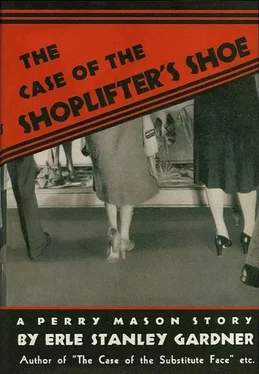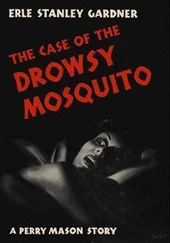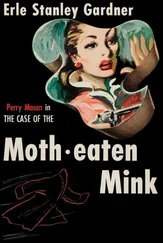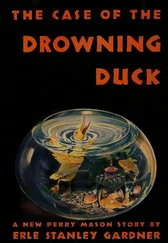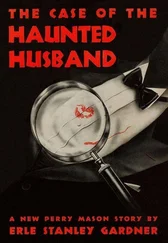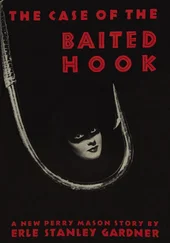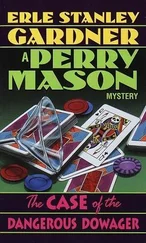“It is very evident, gentlemen, that, as in the case of Cullens, Trent couldn’t have been killed with the gun that the Prosecution claims was used in that murder. Therefore, it becomes equally evident that he must have been killed with the other gun, since there are only two guns and only two fatal bullets, one fatal bullet fired from each gun. It’s very evident that Sergeant Holcomb naturally assumed that the gun in Mrs. Breel’s handbag had killed Austin Cullens, and that the gun in Trent’s office had killed Trent. He took from his right-hand vest pocket the bullet which the autopsy surgeon had handed him as having killed Cullens, and handed it to the witness, Hogan. Hogan checked it with the guns and advised Sergeant Holcomb that that bullet had been fired by the gun found in Trent’s office.”
“What happened?” There was a moment of tense silence, while Mason waited for the point he had made to soak in. “You have seen the character of Sergeant Holcomb,” he said. “He exhibited that character very plainly on the witness stand. He thought that he had confused the bullets; that he had inadvertently transposed the bullets in his pockets, when he had in reality done nothing of the sort. In order to cover up what he fancied was his mistake, he immediately handed the other bullet to Hogan with the statement that that bullet had been the one which killed Cullens.
“It is a little thing, ladies and gentlemen, but it is one of the important little things which become increasingly vital in a case. It is an index to the character of Sergeant Holcomb. Doubtless, he would never have sought to frame this defendant had he thought that she was innocent. But, having thought he’d made a mistake, he tried to cover that mistake, and carried his subterfuge so far as to go on the witness stand and testify to what is a manifest impossibility. Regardless of what the deputy district attorney may tell you, and in spite of Sergeant Holcomb’s testimony, it’s a physical impossibility for the bullet which killed Austin Cullens to have been fired from the Breel gun. On the other hand, it’s a physical impossibility for George Trent to have been killed by the Trent gun.”
“Now then, ladies and gentlemen, if I had been permitted to pursue my proof, I believe I could have demonstrated to you who did murder Austin Cullens. However, since I wasn’t permitted to follow that proof to its logical conclusion, I will take the facts as they now stand, and give you a reasonable hypothesis which will explain away every fact in this case. And not only is that hypothesis consistent with the innocence of the defendant, but the innocence of this defendant is the only hypothesis under which the facts can now be explained.”
“Something happened on the afternoon of Cullens’ death which convinced Sarah Breel that Cullens was responsible for her brother’s disappearance, possibly his death. She went to his house to get evidence. Someone had been there before her. Who was that someone? That was someone who was a dead shot with a revolver, someone who went there for some undisclosed purpose, someone who had access to the revolver with which it now appears the murder must have been committed.
“Austin Cullens saw that person. He knew what that person wanted. He was overcome by the consciousness of his own guilt. He suddenly whipped his revolver from his right hip pocket and fired. The shot missed. But that person had also prepared against just such a contingency. That person was armed. That person fired, and that person did not miss.
“Some time later, Mrs. Breel went to the house. She found the door open. She found the lights out. Remember, ladies and gentlemen, no flashlight was found in her bag. She had to grope her way through the darkness. She did not know that the body of Austin Cullens was lying on the floor. Stumbling her way along the dark room, she suddenly touched something with her left foot.”
“There was only one way in which she could investigate, and that was by a sense of touch. The room was dark. She had no flashlight in her bag. She had no matches in her bag. She bent down, exploring with the tips of her gloved fingers. She touched something hard. She picked it up. It was a revolver. And then she touched a body. Panic-stricken, she wished to call the police. She mechanically, automatically and unconsciously shoved the revolver into her bag and fled from the house, screaming for police. There was no one to hear her screams. She dashed out into the boulevard, and found herself suddenly confronted by a pair of headlights. In her terror, she had forgotten to look before she jumped out into the street.”
“That, ladies and gentlemen, since I have been precluded from making any other explanation, is the explanation which I think you will be forced to adopt from a consideration of the circumstantial evidence in this case.”
“You have sworn to act fairly and impartially. I made no effort to pack this jury with persons who would be favorable to the defendant’s side of the case, because I knew I didn’t have to. All I wanted was people who would be fair. Why, one of your number even mentioned that he had formed an opinion as to the guilt of the defendant, but said he could set aside such an opinion when he entered upon the trial of the case. I had the right to challenge him with a peremptory charge and remove him from the jury. I did not do it. Why? Because I felt that he would be fair, because I knew that he was intelligent. And because all on earth that the defendant in this case wanted was fairness and intelligence. Is that the attitude of a lawyer defending a guilty client? Is that the attitude of one who seeks to ‘razzle-dazzle’ a jury?”
“Ladies and gentlemen, you have sworn to follow the law in this case. When you hear the instructions of the judge, you will realize that this means that you have taken a solemn oath that if the facts of this case can be explained on any reasonable hypothesis other than that of guilt, you will acquit the defendant. Ladies and gentlemen, I leave you to your solemn duty.”
Mason turned and walked back to his seat. Sampson, his face livid, struggling hard to control his voice, leaped up. “Just one word in rebuttal, ladies and gentlemen. Let me challenge Counsel to carry his own argument to its logical conclusion... Who was that person who was such an expert revolver shot? Who was that person, who, by his own evidence had access to the revolver with which he now claims Austin Cullens was murdered — could it have been Virginia Trent, the niece of the woman who is on trial! It must have been! I challenge him to deny it!”
Mason, on his feet, drawled, “Your Honor, I dislike to interrupt the deputy district attorney, but do I now understand the deputy district attorney is contending that Virginia Trent murdered Austin Cullens?”
“According to your own reasoning, it’s as plain as the nose on your face,” Sampson roared.
“Well,” Mason asked, “can you find any flaw in that reasoning? If so, please point it out to the jury.” The color drained out of Sampson’s face. His jaw sagged open in surprise. Mason turned to Judge Barnes. “I was going to suggest, Your Honor, that if it is the contention of the Prosecution that the evidence now shows Virginia Trent murdered Austin Cullens, that this jury must be advised to acquit the defendant in this case. But if the deputy district attorney really wants to know who killed Austin Cullens, I suggest he talk with Paul Drake...”
“That will do, Mr. Mason,” Judge Barnes said. “That statement is improper. You will be seated. The Court will not entertain any motion for a directed verdict, but will let the jury speak for itself — that is, unless it is now the contention of the Prosecution that Virginia Trent committed the crime.”
Читать дальше
